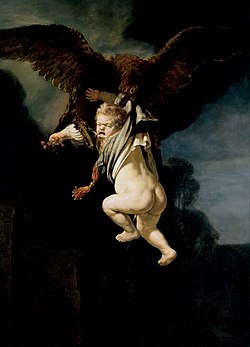The Rape of Ganymede (Rembrandt)
| Rape of Ganymede | |
|---|---|
 | |
| Artist | Rembrandt |
| Year | 1635 |
| Catalogue | Rembrandt Research Project, A Corpus of Rembrandt Paintings VI: #137 |
| Medium | Oil on panel |
| Dimensions | 177 cm × 130 cm (70 in × 51 in) |
| Location | Gemäldegalerie Alte Meister, Dresden |
The Rape of Ganymede (also called The Abduction of Ganymede) is an
Painting
This painting was documented by
Hofstede de Groot did not comment on the theme of this painting at all, though Smith before him found it highly unusual when he wrote:
197. The Rape of Ganymede. If the picture (for the present description is taken from a print) be really by Rembrandt, his intention must have been to burlesque the mythological subject above stated, for he has represented the beautiful Ganymede as a great lubberly child, with a blubbering grimace of countenance, sprawling, with extended arms, in the talons and beak of the eagle Jupiter. The bird has seized him by his unclassical raiments, the weight of his fat body has drawn his clothes up to his shoulders, and left his lower extremities in a state of nudity, and is thus bearing him through the murky air to Olympus. Engraved by A. Cardon. 6 ft. 3 in. by 2 ft. 8 in.—C. Now in the Dresden Gallery.[2]
Interpretation
Rembrandt's depiction of the reluctant Ganymede should be seen not in the Renaissance context of the homo-erotic catamite theme, but in a relatively new Protestant Baroque interpretation of Ganymede as a beloved child "abducted from life too soon".[3] In the 1670s the painter Nicolaes Maes even made a whole series of paintings of Ganymedes that are considered deathbed portraits of children.
-
Early sketch by Rembrandt in the Kupferstich-Kabinett, Staatliche Kunstsammlungen Dresden
-
Die Entführung des Ganymed, by Christian Gottfried Schultze, c. 1780
-
George de Vicq as Ganymede, by Nicolaes Maes, 1681, Fogg Art Museum
An inventory, made on 17 February 1671, of the estate of Catharina van der Pluym, widow of Willem Schilperoort and aunt of Rembrandt's great-nephew and pupil Karel van der Pluym, mentions "een stuck van Ganimedes – f7.- "[4]
See also
References
- ^ Entry 207 for ''The Rape of Ganymede in Hofstede de Groot, 1915
- ^ 546. The Rape of Ganymede in Smith's catalogue raisonne of 1836
- ^ ...d'ontschakinge van Ganymedes, die uytnemende schoon, zijn Ouders vroegh ontstorf, en daerom ontrooft te zijn (English: The abduction of Ganymedes, who left his parents in early death, is therefore a stolen beauty) in Karel van Mander's Schilder-boeck, 1604, in the DBNL
- RKD
Sources
- The rape of Ganymede in the RKD's Rembrandt Database



